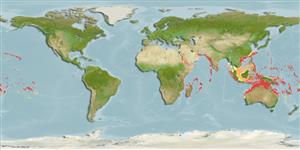Common names from other countries
>
Acanthuriformes (Surgeonfishes) >
Chaetodontidae (Butterflyfishes)
Etymology: Forcipiger: Latin, forceps = instrument of the pincers kind used for seizing and holding objects, esp. In surgical and obstetric operations + latin, gero = to carry; 1634 (Ref. 45335).
Issue
The species Forcipiger cyrano Randall, 1961 is considered as valid in Eschmeyer (CofF ver. Mar. 2011: Ref. 86697) following Randall (2007: Ref. 86689).
Environment: milieu / climate zone / depth range / distribution range
Ecologia
marinhas associadas(os) a recifes; não migratória; intervalo de profundidade 0 - 200 m (Ref. 89972). Tropical; 28°N - 28°S, 32°E - 130°W
Indo-Pacific: East Africa to the Hawaiian, Marquesan, and Pitcairn islands, north to the Bonin [=Ogasawara] Islands, south to New Caledonia and the Austral Islands; throughout Micronesia.
Tamanho / Peso / Idade
Maturity: Lm ? range ? - ? cm
Max length : 22.0 cm TL macho/indeterminado; (Ref. 9710)
Espinhos dorsais (total) : 10 - 11; Raios dorsais moles (total) : 24 - 28; Espinhos anais: 3; Raios anais moles: 17 - 20.
A generally uncommon species that inhabits seaward reefs to depths greater than 60 m (Ref. 9710). Benthopelagic (Ref. 58302). Feeds mainly on whole organisms such as small crustaceans. Usually seen in pairs. Oviparous (Ref. 205), monogamous (Ref. 52884). Forms pairs during breeding (Ref. 205). Sometimes dark brown instead of yellow (Ref. 48636). In the East Indian region this species is replaced by F. wanai at Cenderawasih Bay (Ref. 90102). Minimum depth reported taken from Ref. 128797.
Life cycle and mating behavior
Maturities | Reprodução | Spawnings | Egg(s) | Fecundities | Larvas
Distinct pairing (Ref. 205). Monogamous mating is observed as both obligate and social (Ref. 52884).
Myers, R.F., 1991. Micronesian reef fishes. Second Ed. Coral Graphics, Barrigada, Guam. 298 p. (Ref. 1602)
Categoria na Lista Vermelha da IUCN (Ref. 130435)
CITES (Ref. 128078)
Not Evaluated
Ameaça para o homem
Harmless
Utilização humana
Pescarias: pouco comercial; Aquário: Espécies comerciais
Ferramentas
Relatórios especiais
Descarregue XML
Fontes da internet
Estimates based on models
Preferred temperature (Ref.
115969): 24.7 - 29, mean 27.9 (based on 992 cells).
Phylogenetic diversity index (Ref.
82804): PD
50 = 0.6250 [Uniqueness, from 0.5 = low to 2.0 = high].
Bayesian length-weight: a=0.02291 (0.01212 - 0.04329), b=3.02 (2.86 - 3.18), in cm Total Length, based on LWR estimates for this species & (Sub)family-body (Ref.
93245).
Nível Trófico (Ref.
69278): 3.5 ±0.50 se; based on food items.
Resiliência (Ref.
120179): Elevada, tempo mínimo de duplicação da população menor que 15 meses (Preliminary K or Fecundity.).
Fishing Vulnerability (Ref.
59153): Low vulnerability (12 of 100).
